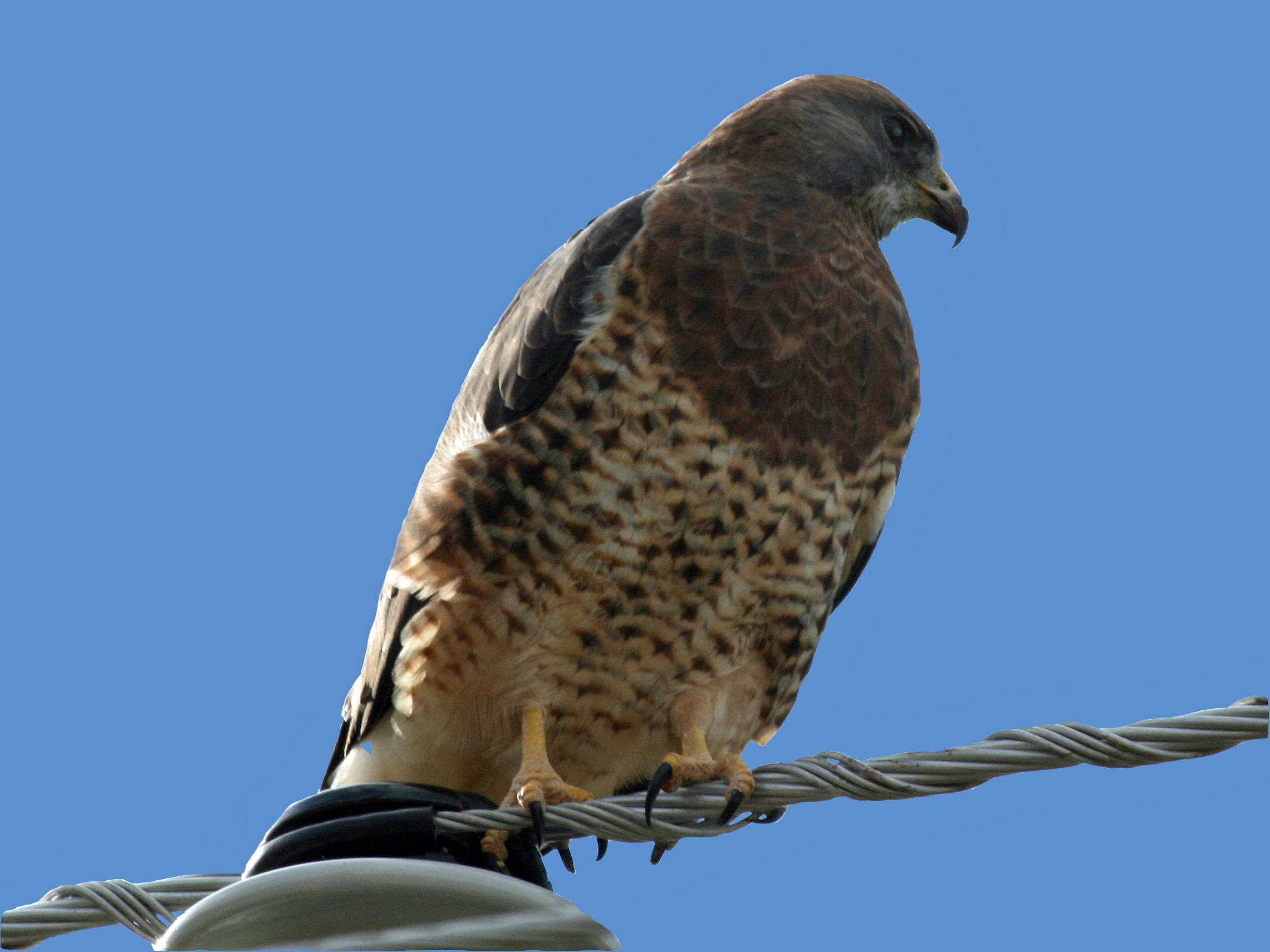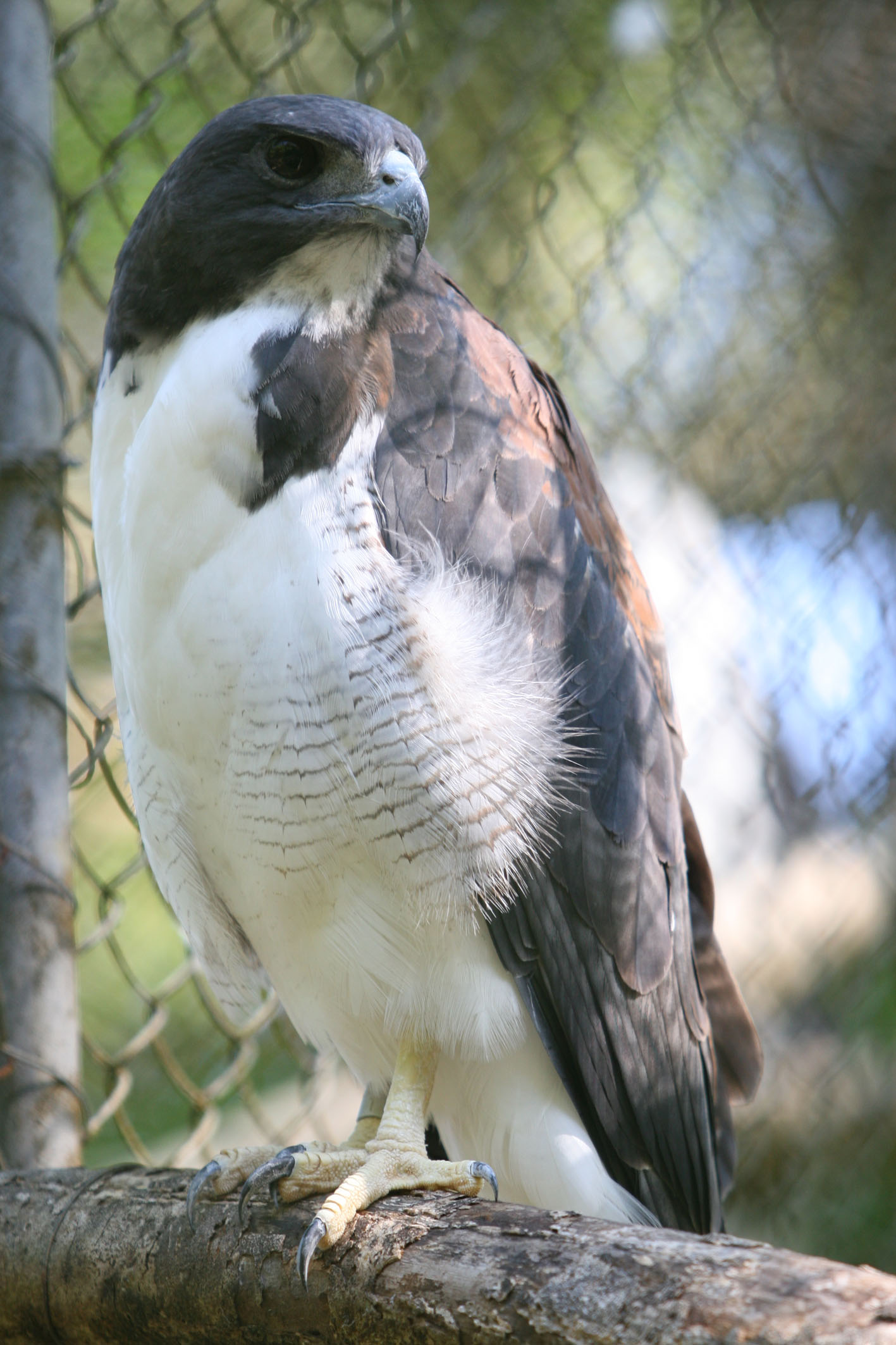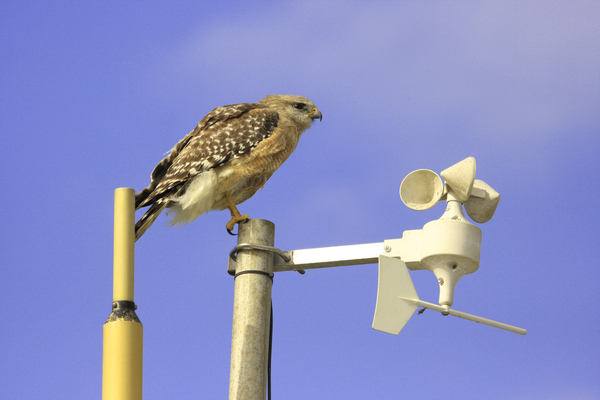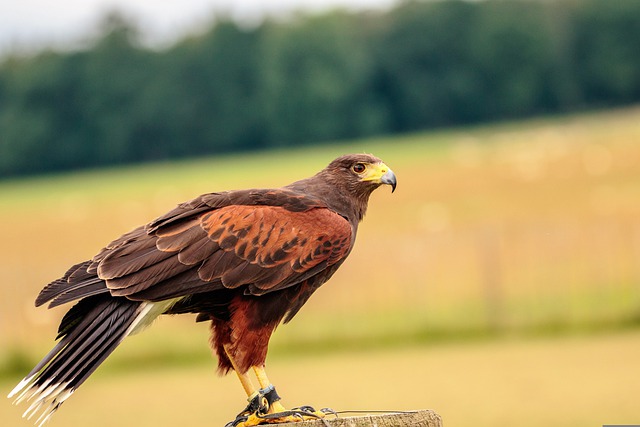Hey there, in this article, I will be discussing the 11 different types of hawks that you can find in Louisiana.
Hawks are a fascinating bird of prey and Louisiana is home to a variety of species.
If you are interested in learning about the different types of hawks that inhabit this southern state, then keep reading.
Whether you’re a birdwatcher or just curious about wildlife, this article will provide you with some insightful information about these magnificent birds.
| Image | Name |
|---|---|
 | Red-Tailed Hawk |
 | Swainson’s Hawk |
 | Rough-legged Hawk |
 | White-Tailed Hawk |
 | Broad-Winged Hawk |
 | Sharp-Shinned Hawk |
 | Cooper’s Hawk |
 | Red-Shouldered Hawk |
 | Northern Harrier |
 | Ferruginous Hawk |
 | Harris's Hawk |
Types of Hawks in Louisiana
1. Red-Tailed Hawk

South Louisiana is home to a variety of birds of prey, including great horned owls, Red-tailed Hawks, and others that prey on swallow-tailed kites.
They often occupy the tops of utility poles and may be spotted soaring over open fields and dense forests.
Being one of the biggest hawks in the state, the red-tailed hawk is sometimes misidentified as an eagle due to its imposing size.
Their wings are large and rounded, their backs are a deep brown color, their bellies are streaked, and their tails are a short, broad shade of crimson red.
Voles, mice, rabbits, and even small dogs and cats are among the prey of these hawks.
Little birds can visit your feeder for a fast meal if you have a large garden and a supply of their favorite food.
If you come across any of these red-tailed hawks in your backyard, it’s best to put away your bird feeder for a few weeks.
The red-tailed hawk’s call is recognizable to most listeners as a thrilling, raspy keee-eeeee-ahhhrr scream.
You’ve undoubtedly noticed this bird before since it’s thought to be the source of most hawk noises in movies.
2. Swainson’s Hawk

Together with red-tailed hawks, Swainson’s hawks are classified as huge hawks and belong to the Buteo family.
When in flight, their wings are spread out in a shallow V formation and are far bigger than the wings of regular buteos.
The majority of Swainson’s Hawks possess chests that are cocoa brown or pale reddish in color, while their underparts are grey or brown.
Its black flying plumage is contrasted strikingly by the thin strip of white that runs around the edge of its wings.
The skulls of the males of this species are grayish, while the heads of the females are covered with brown plumage.
Outside of the time when they are trying to mate, these hawks may nearly always be spotted in large groups.
They have a reputation for being highly sociable, as shown by the fact that you may see them hanging out with their friends on power poles, wooden posts, and towering trees.
It’s interesting to note that the Swainson’s Hawk was once misidentified as the Common Buzzard, and it wasn’t until 1832 that the nephew of Emperor Napoleon figured out the blunder.
The Swainson’s Hawk was formerly a rare migratory in Louisiana, but over the course of the last 20 years or so, there has been a progressive expansion in the area in which they may breed.
The months of August through October are prime times to get a glimpse of them as they make their way northward from the South American regions where they spend the winter.
3. Rough-legged Hawk

Rough-legged Hawks are one of the few winter raptors that may be seen across Louisiana.
Its name comes from the unique plumage that coats its legs.
They are most frequently spotted in open regions, such as meadows, marshes, gulf shores, and mountains, all of which may be found in abundant amounts in the state of Louisiana, sometimes known as the Pelican State.
They have tails that are intricately banded and noticeable white flying feathers.
Their bodies are a dark brown or blackish color with a strong design.
Rough-legged hawks may be identified by their distinctive single-note whistling call, which sounds very similar to the keeeeooowwrr-ing mew of a cat.
Voles and lemmings make up the bulk of their food, although they will also consume the odd squirrel, gopher, rabbit, and bird when the opportunity presents itself.
Yet, when food is scarce during the wintertime, they can resort to eating frogs, insects, or even carrion in order to survive.
They stalk their prey from a distance, watching from high vantage points before diving down, feet first, to seize it with their formidable claws, frequently causing instantaneous death.
Rough-legged hawks, on the other hand, are more likely to be encountered singly or in pairs than Swainson’s hawks.
4. White-Tailed Hawk

Hawks with whitetails are known as white-tailed hawks because of the stark contrast between their black bodies and their white tails, which resemble fans.
Because of their stocky build, white-tailed hawks are sometimes confused for eagles.
While looking for food in their territories, white-tailed hawks may hover or kite over the ground.
These birds are able to rapidly descend to the ground and seize their food in their talons after they have located their target, and then they will return to their nest to enjoy their food.
Grasslands, savannas, pastures, and prairies are common places where one could see one of these hawks.
They consume mostly mammalian species, such as woodrats, pocket gophers, rabbits, and shrews, among others.
On the other hand, they wouldn’t turn down various kinds of invertebrates like grasshoppers, beetles, crawfish, and other insects of a similar kind.
They are not choosy eaters and will consume everything, even dead animals and rattlesnakes.
5. Broad-Winged Hawk

Buteos with the name-inspiring wide wings of a broad-winged hawk, huge heads of a reddish-brown coloration, and chunky bodies of dark brown coloration.
In addition to it, they feature squared-off tails that are short and adorned with beautiful white bands.
During the autumn months in Louisiana, you may see these birds nesting in kettles.
As a result of the fact that they may sometimes be seen in numbers reaching into the thousands, watching them fly is among the most popular things to do across Louisiana.
Broad-winged hawks, like many other types of hawks, pursue their prey from perches inside the forest canopies.
They won’t be picky about what they eat and will gladly consume everything from chipmunks, voles, and shrews to frogs, lizards, and insects if given a chance.
6. Sharp-Shinned Hawk

The sharp-shinned hawk is the tiniest member of the accipiter family that lives across North America.
It is also referred to as a sharp shin, a sharpie, and a blue darter.
They are about the same size as a typical American Kestrel and may be spotted across Louisiana during the wintertime, visiting bird feeders in people’s backyards.
Adult Sharp-shinned Hawks possess crowns that are blue-gray in color and underparts that are banded with rufous and white under tails.
Because of their remarkable similarity to Cooper’s Hawks, people often get the two species confused with one another.
Sharp-shinned birds, on the other hand, have heads that are shorter, feet that are smaller, and a tail that is more squared off than Cooper’s hawks.
Sharp shins are frequently spotted in forests that are predominated by broad-leaved trees, such as oaks and conifers.
Its flight is characterized by rapid, choppy wing beats and brief glides.
While they have a tendency to be fairly hidden, particularly during the mating season, they are most readily spotted throughout Louisiana’s inland and coastal watch locations during migration.
This is because migration is when they are most likely to be traveling.
7. Cooper’s Hawk

When it comes to size, Cooper’s hawks are an excellent middle ground among sharp-shinned hawks and northern goshawks.
These are among the most prevalent types of raptors that can be seen in the state of Louisiana.
The locals could even see them consuming the smaller birds that are attracted to the bird feeders in their gardens.
Cooper’s hawks seldom flap their wings constantly while in flight; rather, they fly in a pattern that consists of flaps followed by glides.
They usually attack their victims by either flying rapidly and low to surprise them or by swooping down quickly from a high altitude.
Both of these tactics are intended to catch their prey off guard.
Cooper’s hawks, like many other species of hawks, are able to make their homes in many kinds of temperate deciduous woods, lush neighborhoods, and the slopes of hilly locations.
The scrub regions, open woodlands, and greenspace could also be good places to look for them.
8. Red-Shouldered Hawk

The red-shouldered hawk is one of the most colorful species of hawk seen around the globe.
Adults often have a checkerboard pattern of black and white on their wings, warm reddish striping on their chests, and dark tails with slender white bars.
These hawks are found in wooded areas that are in close proximity to marshes and rivers, as well as bottomland hardwood stands and highland deciduous forest woods.
There is also a possibility of observing them in suburban and perhaps some residential regions.
The nesting grounds of red-shouldered hawks are frequently located in close proximity to bodies of water, particularly in evergreen and mixed woodland environments.
They are very monogamous and protective of their territory, although they won’t attack until they feel threatened.
The kee-aah screeching sound that red-shouldered hawks make is instantly recognizable and makes them easy to spot.
They are thought to return to their previous nesting region every year, which means that there is a possibility that you may run across the same hawk that you’ve seen in the past, even if it’s been many years since the last time you did so.
9. Northern Harrier

The Northern Harrier is a unique species that cannot be compared to any of the other hawks on this list.
They resemble owls but have the bodies of eagles and short bills that are hooked quite sharply.
They fly with their wings folded in a dihedral position, also known as a V-shape.
Female Northern Harriers possess brown upperparts, white underparts, and black stripes on their tails; male Northern Harriers, on the other hand, have greyish upperparts and whitish underparts, earning them the moniker “grey ghost.”
Both possess white spots on the back of their rump that are visible while the bird is flying.
In contrast to the majority of hawk species, male and female northern harriers make sounds that are easily distinguishable from one another.
The piiihh-eeh sound is typically produced by females, but the chek-chek-chek cry is characteristic of males.
Open meadows and wetlands are typical habitats for northern harriers to be found in.
The mice, rats, and voles that make up the majority of their meals are supplemented with songbirds, snakes, rabbits, frogs, and lizards on occasion.
When they are on the hunt, males fly lower to the ground and quicker than females do at the same altitude.
They seek prey using their acute hearing, much as owls do, which is a similar adaptation.
10. Ferruginous Hawk

The Ferruginous Hawk is a huge bird that is distinguished by its massive, white head, pastel wings, underbellies, and reddish-orange colored feathery legs.
They may be identified by these characteristics.
Throughout the late fall, wintertime, and early spring months, the southwestern region of Louisiana is the most likely place to see one of these hawks.
In the state of Louisiana, these hawks are most often seen in the areas around grasslands, shrublands, and the borders of woods.
Some Ferruginous Hawks even make their homes in areas with fewer trees or open terrain, where they construct enormous nests out of branches, twigs, and detritus.
It is interesting to note that during the mating season, which begins in the early spring, couples fly in circles over their respective nesting locations while making their distinctive sounds.
Young hawks often have screams that are in the higher octaves, in contrast to adult hawks, which have a distinctive scratchy, screaming sound.
11. Harris’s Hawk

The Harris’s Hawk is a hawk that may grow out to be very big and has brown plumage with brightly colored wings that set it apart from other hawks.
In addition, these hawks may be identified by the white markings that are seen on their tails.
In contrast, the underparts of young hawks may be marked with a wide range of white spots and spots of varying sizes.
These hawks are not strictly speaking locals, but it is not unheard of for them to be seen across Louisiana, especially in the southern parts of the state.
You will most often discover them in trees of a greater height, and you can recognize their nests by the broad range of materials that are used to construct them, including rubbish, twigs, and even some things manufactured by humans.
Beginning in March and continuing through the summer season, your greatest opportunity to see these hawks will be during those two seasons.
A call that has been described as sounding “scratchy” and may persist for up to a few seconds can be used to identify these hawks.
Conclusion
In conclusion, Louisiana is home to a diverse array of hawks, each with its unique characteristics and behaviors.
From the iconic red-tailed hawk to the less well-known sharp-shinned hawk, these birds of prey play a vital role in maintaining a healthy ecosystem.
Understanding the different types of hawks in Louisiana can help bird enthusiasts and nature lovers appreciate the beauty and importance of these fascinating creatures.
With their sharp talons, keen eyesight, and powerful wings, hawks remind us of the incredible adaptability and resilience of nature.
By protecting and preserving their habitats, we can ensure that future generations will have the opportunity to witness the majesty of these magnificent birds.
FAQ
What is the difference between a hawk and an eagle?
While hawks and eagles are both birds of prey, there are some key differences between them. Eagles are generally larger than hawks and have longer wingspans. They also have a distinctive hooked beak and often have feathered legs. In contrast, hawks are smaller and have shorter wingspans. Their beaks are not as curved as eagles’, and they have unfeathered legs.
Do hawks migrate in Louisiana?
Yes, some hawk species do migrate through Louisiana during certain times of the year. For example, the broad-winged hawk is a neotropical migrant that passes through Louisiana in large numbers during the fall migration. Other hawk species, such as the red-tailed hawk, are resident year-round and do not migrate.
Can hawks be kept as pets?
No, it is illegal to keep hawks or any other birds of prey as pets in the United States without a special permit. In addition, hawks are wild animals that require specialized care and handling, so they are not suitable as pets.
How do hawks hunt for food?
Hawks use a variety of hunting techniques depending on their species and habitat. Some hawks, such as the red-tailed hawk, hunt from a perch or by soaring high in the sky and diving down to catch prey. Others, such as the Cooper’s hawk, use dense cover to surprise their prey or chase them through trees and shrubs.
Are hawks beneficial to the environment?
Yes, hawks play a vital role in maintaining a healthy ecosystem by controlling populations of rodents and other small mammals. They are also an important indicator of environmental health and can help researchers monitor changes in the environment over time.
Last Updated on April 27, 2023 by Lily Aldrin
